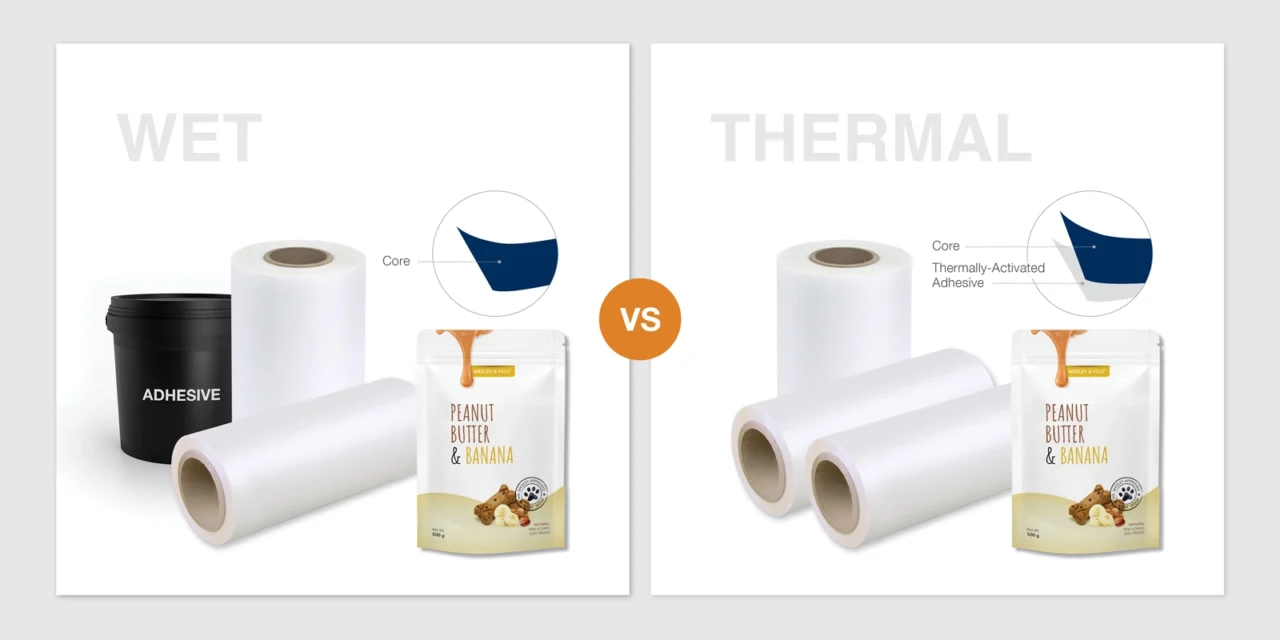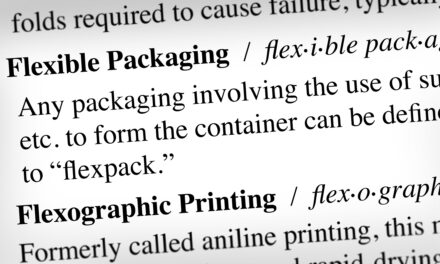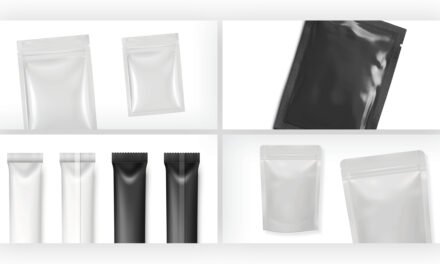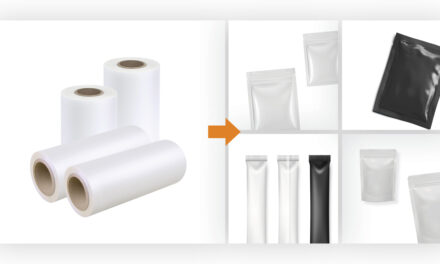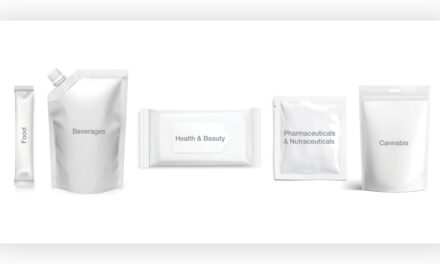LAMINATING THE PRINT LAYER ON FLEXIBLE PACKAGING
The print layer on flexible packaging plays an important role in protecting ink, making designs pop, and adding overall value to the product. Whether a flexible packaging converter uses pre-laminations or assembles their own structures in-house, the print web serves as a vital final layer for durable, high-quality packaging.
While converters with a flexographic press typically add this final layer through in-line lamination, converters with a digital press must perform lamination near-line as digital printing technology currently does not support in-line lamination. This means digital converters have the flexibility to choose which lamination method they want to use and should understand the strengths and drawbacks of different techniques to make an informed decision.
This article will take a brief look at wet lamination (which includes solventless, solvent-based, and water-based lamination) and thermal lamination as two popular yet distinct lamination methods for flexible packaging. We will examine how each laminating process is performed and analyze the factors that might push a flexible packaging converter to choose one method over another when making an equipment investment.
LAMINATION METHODS
Whether the adhesive used is a thermally activated layer (EVA) or a wet adhesive with a specific carrier, each lamination method can produce high-quality flexible packaging so long as the operator is knowledgeable about the materials and equipment being used. Still, these lamination types differ in major ways that can have a large impact on other aspects of a flexible packaging business besides quality.
Wet Lamination (Solventless, Solvent Based, and Water Based)
Solventless, solvent-based, and water-based lamination all utilize wet adhesives, but they differ in which carrier is used. Most modern flexible packaging converters prefer solventless adhesives as they are typically more cost effective, easier to use, and safer for people and the environment, but solvent- and water-based adhesives each have their own perks depending on the application type. This type of lamination can be performed in-line on a flexographic press, but dedicated laminating systems are also available for use with digital presses.
Before starting the machine, the operator pours the adhesive into the appropriate deck; the adhesive is then transferred to the web via a series of rollers. The overlaminate film and printed web are both loaded onto their respective mandrels and fed through a series of rollers that guide them through the machine. In cases where reverse printing is used to minimize the layers in a package while still protecting the ink, the overlaminate film may be the layer that receives ink. When the laminate film and the print web are pressed against each other, the adhesive binds the layers together through a chemical reaction.
Unlike with thermal lamination, the print web must go through a drying process in an oven before being left to cure over time to ensure the film layers remain bonded together. This curing period can vary depending on the chemical composition of the adhesive, but standard times range anywhere from hours to two days for a full cure. Only after the adhesive is cured can the quality of the lamination job be confirmed and the laminated web sent on for further processing. The decks and rollers used to apply the adhesive must be cleaned regularly to prevent adhesive from accumulating or drying on the equipment.
Thermal Lamination
In contrast to other lamination methods, thermal lamination requires the converter to purchase film that already includes an adhesive layer. This solid adhesive, which is typically made of a polymer such as EVA, is specifically designed to melt at a lower temperature than the base film it is attached to. Like adhesive-free films, thermal laminates come in rolls that are loaded onto a mandrel on a thermal laminator.
Other key components on a thermal laminating system include the nip rollers (also called pressure rollers) and the chrome roller. Nip rollers help maintain proper tension, pull the web through the unit, and apply pressure to the laminate and substrate to ensure a strong bond. As the nip rollers pull the web through the machine, the chrome roller applies heat to the top of the laminate, warming up the EVA adhesive and softening it so it can bond properly to the substrate. Solventless lamination also utilizes nip rollers, but chrome rollers are entirely unique to thermal laminators.
Because the adhesive is made of a polymer that solidifies at room temperature, thermally laminated structures cure as soon as they leave the chrome roller. From there, the laminated web can immediately be sent on for value-add embellishments or shaping, filling, and sealing. Thermal laminates require no clean up and very little set up, and most modern thermal laminators include software that automates different steps in operation, including pre-programmed settings and auto detection features for sheet overlap, misfeeding issues, and temperature settings.
HOW TO CHOOSE A LAMINATION METHOD
Now that we have an overview of what makes each lamination method unique, we can take a closer look at a few of the key concerns most flexible packaging converters want to address when choosing which type of system to invest in.
Speed to Market
While many brands are accustomed to lead times ranging from several days to several weeks, more and more brands are seeking out flexible packaging converters who offer short lead times to give their products an edge over the competition. Especially in niche markets and for products with short shelf lives. Being able to provide brands with next-day packaging can prove to be a huge advantage for flexographic and digital converters alike.
If your operation wants to tout speed to market as a partnership benefit, it is difficult to compete with the turnaround time of thermal lamination. Cleanup is simple as there are no wet adhesives to clean or store, and because the thermal adhesive cures immediately after lamination, the laminated web can be sent on for further processing immediately. With an optimized workflow, a skilled flexible packaging converter can turn around some orders in a single day.
However, solventless lamination and other wet lamination methods need time to cure properly to ensure the package’s integrity is not affected. If the package is sent for embellishments or shaping too quickly, the outermost layer may begin to peel off at the edges or develop other quality issues. Additionally, a wet lamination system takes more time to set up as the viscous adhesive must be added to the machine and then cleaned out afterwards. Sometimes different adhesives must be used for different jobs, adding time for changeovers. While wet lamination has many advantages, thermal lamination is the ideal option when speed to market is the top priority.
Volume
Thermal laminators may be faster in curing time, but they have a lower maximum speed than solventless lamination systems because heat is a crucial component in proper adhesion. When a thermal laminate passes under the heated chrome roller, it must stay in contact with the roller long enough for the adhesive to be activated. Running a thermal laminator too quickly will result in poor-quality lamination as the adhesive cannot bond properly with the entire substrate.
Wet lamination systems can run higher volume jobs much more quickly as the laminator does not need to melt the adhesive. The liquid adhesive can be rolled onto the web quickly and efficiently, producing large volumes of impressions in a single run. Depending on the number of impressions in a run, flexible packaging laminated with a solventless adhesive may be able to go through lamination, curing, and post-laminate processing in the time it takes a thermal laminator to finish laminating the web.
Price
When it comes to lamination methods, pricing depends on a wide range of factors. A roll-to-roll thermal laminating system is almost always less expensive than a dedicated solventless lamination system, but this can be highly dependent on the manufacturer. Even after considering the initial equipment investment, converters should think about where they will source their laminates, films, adhesives, and any other materials they will need.
Thermal laminates, especially those with specialty finishes or material types, are typically more expensive than their equivalent adhesive-free counterparts. Conversely, adhesive-free films require less processing, are lighter in shipping, and ultimately take up less room pound for pound. Wet adhesives are purchased separately from the film, enabling the converter to select their vendors carefully based on both quality and pricing, two considerations that are often a packaged deal for thermal laminates.
If price per impression is the ultimate concern for a flexible packaging operation, wet lamination will allow for greater control over sourcing, pricing, and storage compared to thermal lamination. However, if the initial investment takes priority, a thermal laminator can backend the cost by allowing a converter to get into the market quickly and spend a bit more on thermal laminates.
READY TO EXPLORE PRINT WEB FILMS?
Nobelus offers both thermal laminates and adhesive-free films in our product portfolio. All our products are high quality and come with full technical support and guidance from our in-house solutions experts. We offer flexible packaging converters specialized finishes and support for different packaging formats and market segments, but we also have essential gloss and matte finishes to ensure every converter has the materials they need. Contact us for more information about the finishes we offer for thermal and wet lamination and order a sample to see the quality of our products for yourself.

